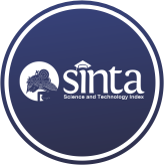Prediksi Jumlah Pasien Medical Check Up Berdasarkan Time Series Forecasting Menggunakan Algoritma XGBoost
(1) Universitas Nasional, Jakarta, Indonesia
(*) Corresponding Author
Abstract
Full Text:
PDFReferences
H. B. Sukendar, “Pemberdayaan Masyarakat Miskin Melalui Peningkatan Layanan Kesehatan oleh Rumah Sehat BAZNAS Yogyakarta di Desa Wukirsari,” SANGKéP J. Kaji. Sos. Keagamaan, vol. 1, no. 2, pp. 132–142, 2018.
A. . Patattan, “Hubungan mutu pelayanan kesehatan dengan kepuasan pasien di Rumah Sakit Fatima Makale di era new normal,” J. Keperawatan Florence Nightingale, vol. 4, no. 1, pp. 14–19, 2021.
S. Hade, A. Djalla, and A. D. . Rusman, “Management Information Systems in an Effort to Improve Health Services at Andi Makkasau Hospital Parepare,” Ilm. Mns. Dan Kesehat., vol. 2, pp. 293–305, 2019.
A. Yani, “Utilization of technology in the health of community health. PROMOTIF,” J. Kesehat. Masy., vol. 8, no. 1, pp. 97–103, 2018.
A. W. Maghfiroh, N. Ulinnuha, and A. Fanani, “Penerapan Fuzzy C-Means dalam Mengelompokkan Kabupaten/Kota Berdasarkan Fasilitas Pelayanan Kesehatan Di Jawa Timur,” Inf. J. Ilm. Bid. Teknol. Inf. dan Komun, vol. 4, no. 1, pp. 8–14, 2019.
C. Chandra and S. Budi, “Analisis Komparatif ARIMA dan Prophet dengan Studi Kasus Dataset Pendaftaran Mahasiswa Baru,” J. Tek. Inform. dan Sist. Inf., vol. 6, no. 2, pp. 278–287, 2020, doi: 10.28932/jutisi.v6i2.2676.
E. E. Etu et al., “A comparison of univariate and multivariate forecasting models predicting emergency department patient arrivals during the COVID-19 pandemic,” Healthc. MDPI., vol. 10, no. 6, p. 1120, 2022.
M. Alim, G. H. Ye, P. Guan, D. S. Huang, B. Sen Zhou, and W. Wu, “Comparison of ARIMA model and XGBoost model for prediction of human brucellosis in mainland China: A time-series study,” BMJ Open, vol. 10, no. 12, pp. 1–8, 2020, doi: 10.1136/bmjopen-2020-039676.
J. R. Saura, D. Ribeiro-Soriano, and D. Palacios-Marqués, “Setting B2B digital marketing in artificial intelligence-based CRMs: A review and directions for future research,” Ind. Mark. Manag., vol. 98, pp. 161–78, 2021.
M. Xue, L. Wu, Q. P. Zhang, J. X. Lu, X. Mao, and Y. Pan, “Research on load forecasting of charging station based on XGBoost and LSTM model,” J. Phys. Conf. Ser., vol. 1757, no. 1, p. 012145, 2021.
D. Gunawan and W. Astika, “The Autoregressive Integrated Moving Average (ARIMA) Model for Predicting Jakarta Composite Index,” J. Inform. Ekon. Bisnis, vol. 1, no. 6, 2022.
C. X. Lv, S. Y. An, B. J. Qiao, and W. Wu, “Time series analysis of hemorrhagic fever with renal syndrome in mainland China by using an XGBoost forecasting model,” BMC Infect. Dis., vol. 21, pp. 1–13, 2021.
DOI: https://doi.org/10.30645/kesatria.v6i2.592
DOI (PDF): https://doi.org/10.30645/kesatria.v6i2.592.g587
Refbacks
- There are currently no refbacks.
Published Papers Indexed/Abstracted By:














